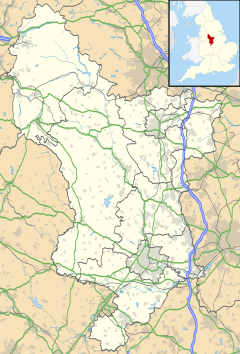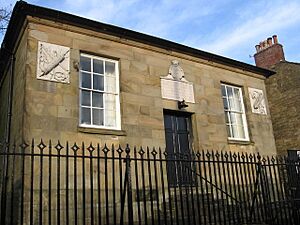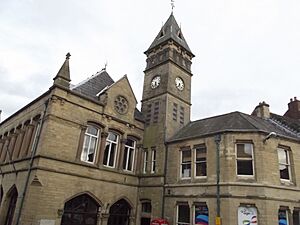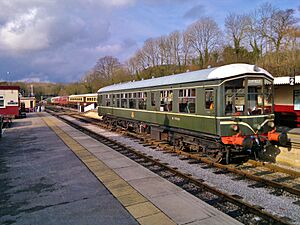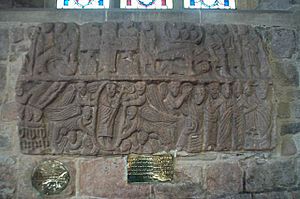Wirksworth facts for kids
Quick facts for kids Wirksworth |
|
|---|---|
 Market Place |
|
| Population | 5,220 (2023 estimate) |
| OS grid reference | SK2853 |
| District |
|
| Shire county | |
| Region | |
| Country | England |
| Sovereign state | United Kingdom |
| Post town | MATLOCK |
| Postcode district | DE4 |
| Dialling code | 01629 |
| Police | Derbyshire |
| Fire | Derbyshire |
| Ambulance | East Midlands |
| EU Parliament | East Midlands |
| UK Parliament |
|
Wirksworth is a historic market town in the Derbyshire Dales area of England. In 2023, about 5,220 people lived here. The town is where the River Ecclesbourne begins its journey.
Wirksworth received a special market charter from King Edward I in 1306. This means it was officially allowed to hold markets. Even today, you can find a market happening in the Memorial Gardens every Tuesday. The town's church, St Mary's, is very old, possibly dating back to the year 653! Wirksworth grew important because of lead mining and stone quarrying. Many lead mines were owned by the Gell family, who lived nearby at Hopton Hall.
Contents
- What Does the Name Wirksworth Mean?
- A Look Back at Wirksworth's History
- Wirksworth's Location and Layout
- Learning in Wirksworth: Schools
- Getting Around Wirksworth: Transport
- Wirksworth in the Media
- Fun Things to Do and See in Wirksworth
- Famous People from Wirksworth
- Important Landmarks and Buildings
- See also
What Does the Name Wirksworth Mean?
The name Wirksworth has a long history. It was first written as Werchesworde in the Domesday Book of 1086 A.D. This was a huge survey of England ordered by William the Conqueror.
The name might mean "Weorc's enclosure" or "fortified enclosure." This suggests it was a protected place long ago. Some nearby farms and villages like Cromford and Carsington were once part of Wirksworth's larger area.
A Look Back at Wirksworth's History
How Did Wirksworth Begin?
Wirksworth likely started because of its natural features. There were warm water springs nearby, and the town was in a sheltered valley. This made it a good place to grow crops like oats and find wood for building.
The area around Wirksworth, known as the White Peak, has signs of very old human activity. People lived here during the Stone Age (Neolithic) and Bronze Age.
Ancient Discoveries in Local Caves
In 1822, lead miners found bones of a Woolly rhino in a place called Dream Cave. This cave is on private land between Wirksworth and Carsington Water. Another nearby cave also revealed ancient items in the late 1900s.
The Story of Lead Mining in Wirksworth
Lead mining was a huge part of Wirksworth's past.
Roman Times and Early Mining
During Roman Britain, the limestone hills of Derbyshire were a major source of lead. Many believe Wirksworth might have been the important Roman lead mining center called Lutudarum. Roman roads from Wirksworth led to other towns like Buxton and Brough-on-Noe.
Wirksworth has the oldest town charter in the Peak District, given in 835. This shows how important it was even then.
Mining in Anglo-Saxon and Medieval Times
In Anglo-Saxon times, many lead mines were owned by Repton Abbey. The Domesday Book mentions three mines in Wirksworth. Scientists have even found that lead pollution in European air between 1170 and 1216 was as high as during the Industrial Revolution. This was likely due to lead and silver smelting around Wirksworth!
Inside Wirksworth Church, there's a tiny carving of a miner with his tools. This figure is called "T'Owd Man of Bonsall." It reminds us of the town's mining past.
Rules for Miners: The Barmote Court
In 1288, during King Edward I's rule, a special court called the barmote court was set up in Wirksworth. Its job was to control lead mining. Anyone could dig for ore almost anywhere, except in churchyards, gardens, or roads. To claim a spot, a miner just needed to set up their winch and dig enough ore to pay a tribute to the "barmaster." The building where this court met, the Moot Hall, was built in 1814.
New Ways of Mining in the 1700s
By the 1700s, thousands of small lead mines were operating. The London Lead Company was formed to help fund deeper mines. They introduced new ways to drain water from the mines, like soughs (drainage tunnels) and Newcomen steam-engine pumps.
The Gell Family's Influence
The Gell family of Hopton Hall had strong ties to many important places in the area. One family member, Anthony Gell, started the local grammar school. Another, Phillip Gell, built the Via Gellia. This road helped transport lead from the family's mines to a smelter in Cromford. Today, the local school is named Anthony Gell School in his honor.
Quarrying Limestone in Wirksworth
The carboniferous limestone around Wirksworth has been quarried for a very long time. This has created many rock faces and cliffs around the town.
The Industrial Revolution Comes to Wirksworth
In 1777, Richard Arkwright rented a corn mill and turned it into a cotton spinning mill. This was special because it was the world's first cotton mill to use a steam engine to help power its waterwheel.
Later, this mill became known as Haarlem Mill. It was used to weave tape. Another nearby mill, Speedwell Mill, also made tape. Together, these mills employed 230 people! They produced so much tape that it was said their weekly output could go around the Earth. Wirksworth became famous for making "red tape" for the government offices in London.
Today, Haarlem Mill is an art center. The success of these industries led to the building of Wirksworth Town Hall in 1871.
Wirksworth's Location and Layout
In 2011, Wirksworth civil parish had over 5,000 people living in about 2,256 homes.
The town has different areas:
- Yokecliffe is to the west.
- Gorseybank and Bournebrook are to the south-east.
- Miller's Green is to the south-west.
- Steeple Grange and Bolehill are to the north. Bolehill is actually a very old part of the town.
There are plans to build new homes in the future, especially north of the town center and in the old Middle Peak Quarry.
Learning in Wirksworth: Schools
Wirksworth has several schools:
- Church of England and county infant schools.
- Wirksworth Junior School.
- The Anthony Gell School, for students aged 11-18.
- Callow Park College.
The Anthony Gell School is named after a local person who helped start a grammar school. The school has about 800 students and is known as a Sports College. Its houses are named after important figures like Fearne, Arkwright, Wright, Gell, and Nightingale.
Getting Around Wirksworth: Transport
The Wirksworth railway station is part of the heritage Ecclesbourne Valley Railway. You can take a train from here to Duffield. From Duffield, you can connect to the main train network for trips to Nottingham, Derby, and Matlock.
The town also has several bus routes connecting it to other places like Derby, Bakewell, Sheffield, and Ashbourne.
Wirksworth in the Media
For local news and TV, Wirksworth gets its signals from BBC East Midlands and ITV Central.
Local radio stations include BBC Radio Derby, Capital Midlands, and Greatest Hits Radio Midlands. The weekly local newspaper for the town is the Matlock Mercury.
Fun Things to Do and See in Wirksworth
Local Events and Traditions
Wirksworth has many interesting events throughout the year:
- Wirksworth Book Festival: This festival, started in 2016, celebrates books and local writers. It happens in early April.
- Wirksworth Well Dressing and Carnival: In early June, the town celebrates well dressing. This old custom involves decorating natural springs and taps with beautiful pictures made from flower petals and natural materials.
- Clipping the Church: On the first Sunday after September 8th, people join hands to form a circle around the church. This is a very old tradition that celebrates the church's dedication.
- Wirksworth Festival: Every September, this festival celebrates arts and crafts. You can see exhibitions and street performances.
- Annual Pantomime: In the first weekend of December, the Glee Club puts on a fun pantomime show.
Community Places to Visit
- Fanny Shaw's Playing Field: This is a main recreation area in the north of town, with a play area for kids.
- The "Rec": In the south, you'll find another children's play area, plus fields for cricket and football.
- There are public toilets available in the car park near the United Reformed Church.
Town Twinning
Wirksworth has special friendships with two towns in other countries:
- Die in southern France.
- Frankenau in Germany.
These friendships are managed by the Wirksworth Twinning Association.
Famous People from Wirksworth
- Lawrence Beesley (1877–1967): A science teacher and writer who survived the sinking of the Titanic.
- Abraham Bennet (1749–1799): He was a church leader in Wirksworth and did important early work with electricity.
- D. H. Lawrence (1885–1930): A famous writer who lived near Wirksworth for a time. He wrote a short story called "A Wintry Peacock" while living there.
- Frederick Treves (1853–1923): A surgeon and author who practiced in Wirksworth. A house in town is named after him.
Important Landmarks and Buildings
Wirksworth has 108 listed buildings and structures. These are protected by Historic England because they are important historically or architecturally. The parish church of St Mary is a very important Grade I listed building. Other notable buildings like Haarlem Mill and the Red Lion Hotel are also listed.
The Wirksworth Heritage Centre is a great place to learn about the town's past. It shows everything from prehistoric times with woolly rhinos to its Roman and lead mining history, right up to today.
See also
 In Spanish: Wirksworth para niños
In Spanish: Wirksworth para niños


